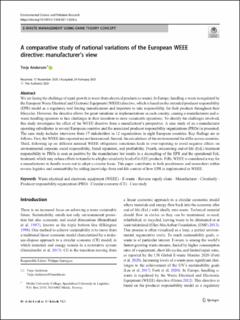| dc.contributor.author | Andersen, Terje | |
| dc.date.accessioned | 2024-03-11T10:10:53Z | |
| dc.date.available | 2024-03-11T10:10:53Z | |
| dc.date.created | 2021-03-02T11:57:17Z | |
| dc.date.issued | 2022 | |
| dc.identifier.citation | Environmental Science and Pollution Research International. 2022, 29 (14), 19920-19939. | en_US |
| dc.identifier.issn | 0944-1344 | |
| dc.identifier.uri | https://hdl.handle.net/11250/3121759 | |
| dc.description.abstract | We are facing the challenge of rapid growth in waste from electrical products (e-waste). In Europe, handling e-waste is regulated by the European Waste Electrical and Electronic Equipment (WEEE) directive, which is based on the extended producer responsibility (EPR) model as a regulatory tool forcing manufacturers and importers to take responsibility for their products throughout their lifecycles. However, the directive allows for great variations in implementations in each country, causing e-manufacturers and e-waste handling operators to face challenges in their transition to more sustainable operations. To identify the challenges involved, this study investigates the effect of the WEEE directive from a manufacturer’s perspective. A case study of an e-manufacturer operating subsidiaries in several European countries and the associated producer responsibility organizations (PROs) is presented. The case study includes interviews from 17 stakeholders in 12 organizations in eight European countries. Key findings are as follows. First, the WEEE data reported are not harmonized. Second, the calculations of the environmental fee differ across countries. Third, following up on different national WEEE obligations sometimes leads to over-reporting to avoid negative effects on environmental corporate social responsibility, brand reputation, and profitability. Fourth, outsourcing end-of-life (EoL) treatment responsibility to PROs is seen as positive by the manufacturer but results in a decoupling of the EPR and the operational EoL treatment, which may reduce efforts to transfer to a higher circularity level of its EEE products. Fifth, WEEE is considered a way for e-manufacturers to handle waste not to adopt a circular focus. This paper contributes to both practitioners and researchers within reverse logistics and sustainability by adding knowledge from real-life context of how EPR is implemented in WEEE. | en_US |
| dc.language.iso | eng | en_US |
| dc.relation.uri | https://doi.org/10.1007/s11356-021-13206-z | |
| dc.rights | Navngivelse 4.0 Internasjonal | * |
| dc.rights.uri | http://creativecommons.org/licenses/by/4.0/deed.no | * |
| dc.title | A comparative study of national variations of the European WEEE directive : manufacturer’s view | en_US |
| dc.type | Peer reviewed | en_US |
| dc.type | Journal article | en_US |
| dc.description.version | publishedVersion | en_US |
| dc.source.pagenumber | 19920-19939 | en_US |
| dc.source.volume | 29 | en_US |
| dc.source.journal | Environmental Science and Pollution Research International | en_US |
| dc.source.issue | 14 | en_US |
| dc.identifier.doi | 10.1007/s11356-021-13206-z | |
| dc.identifier.cristin | 1894874 | |
| cristin.ispublished | true | |
| cristin.fulltext | original | |
| cristin.qualitycode | 1 | |

